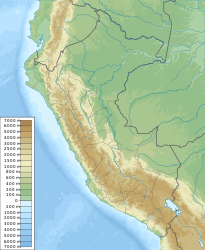Lunahuaná
| Lunahuaná | ||
|---|---|---|
|
|
||
| Coordinates | 12 ° 58 ′ S , 76 ° 8 ′ W | |
| Basic data | ||
| Country | Peru | |
| Lima | ||
| province | Cañete | |
| ISO 3166-2 | PE-LIM | |
| District | Lunahuaná | |
| height | 479 m | |
| Residents | 2617 (2017) | |
|
Templo Católico de Santiago the church in Lunahuaná
|
||
Lunahuaná is a small village in the province of Cañete in Peru . The place is about 187 km south of Lima in the Lunahuaná valley on the raging river Río Cañete . Lunahuaná is 479 meters above sea level . Due to the unique landscape, Lunahuaná is a very popular destination for both Peruvians and tourists. The 2017 census counted 2,617 inhabitants, 10 years earlier 2529.
history
The name Lunahuaná originally comes from Quechua . It is made up of the words runa ("people") and huanac ("he who punishes"). So the literal meaning is "he who punishes people". The Lunahuana Valley was the destination of Inca conquests. At first the valley was settled by the Guarco . Due to the natural obstacles with the wild Rio Cañete, the Inca campaigns lasted three to four years. The ruins of the Incawasi fortress eight kilometers from Lunahuaná still reminds of the successful conquest. Túpac Yupanqui was part of these campaigns. Lunahuaná was officially founded as a market town in 1821 by Don José de San Martín.
Attractions
In the center of the village is the Catholic church built in 1690 by the Franciscan Order. The main square ( Plaza de Armas ) , which is typical of Latin America, is located near the church . In 1972 the church was declared a Historic Monument.
The main attraction of Lunahuaná, however, is the Cañete River, which with rapids up to class 4 is a popular destination for white water rafting tours . Other popular activities include hiking , mountain biking , paragliding, and fishing .
Eight kilometers from Lunahuaná is the Incawasi Inca fortress. The complex is divided into three areas. First there is the Inca quarter ( El Barrio Incaico ). This is followed by a religious center or the so-called Colcas ( El Barrio Religioso o de las Colcas ). Colcas was what the Incas called their department stores and warehouses. Finally there is the Palace of the Incas ( El Palacio del Inca ).
Individual evidence
- ↑ PERU: Lima Region: Provinces & Places . www.citypopulation.de. Retrieved December 28, 2019.


